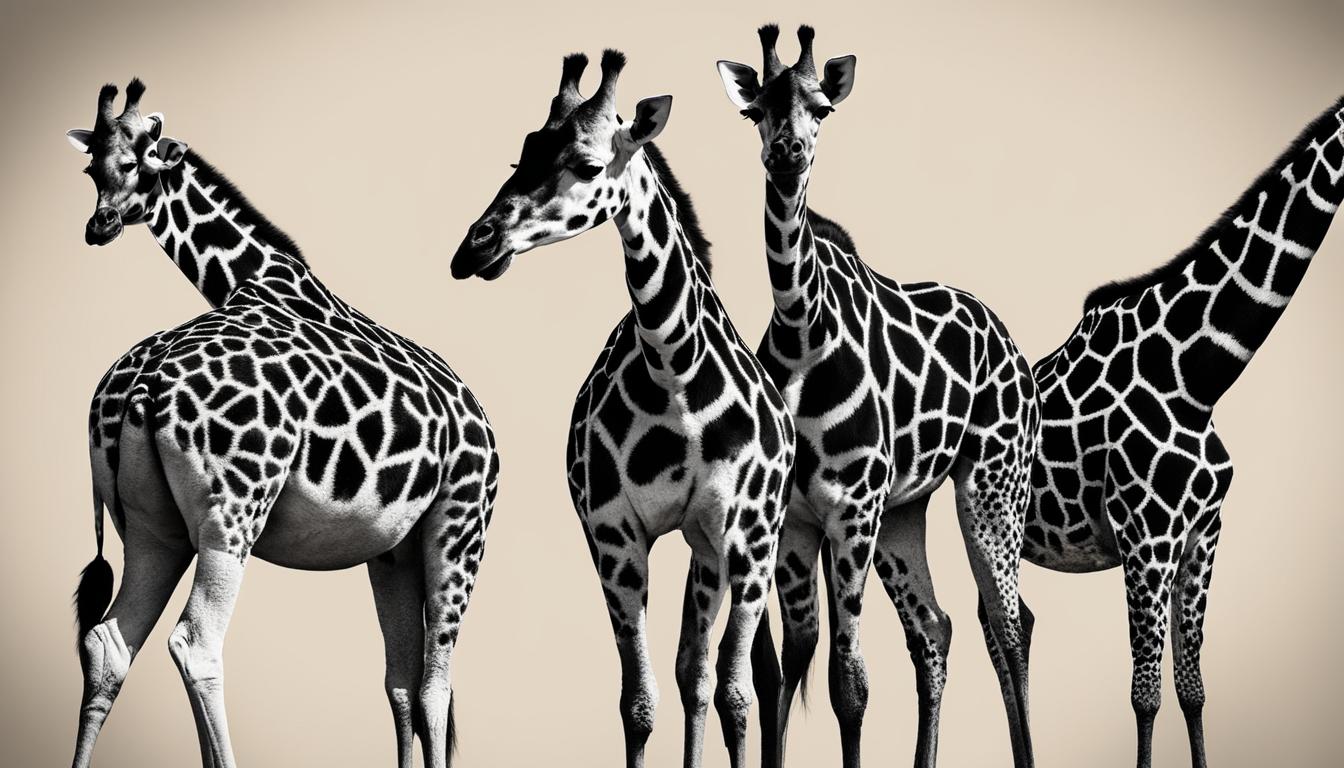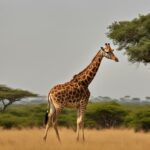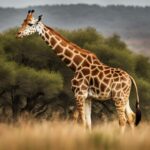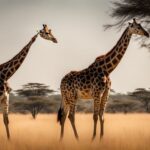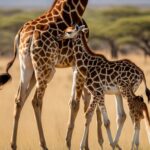Giraffes are known for their distinct patterns and markings, which vary among different subspecies. Each giraffe has its own unique pattern style, making them truly one-of-a-kind. The patterns on a giraffe’s coat serve as both an aesthetic feature and a form of camouflage in their natural habitat. The colors of their coats also differ depending on the subspecies and the vegetation in their environment.
Different Subspecies of Giraffes and their Patterns
Giraffes are fascinating creatures with a variety of subspecies, each exhibiting unique spot patterns and color variations. Let’s explore some of the different subspecies and their distinct patterns:
Reticulated Giraffe
The reticulated giraffe is known for its dark brown spots and narrow lines in between, creating a web-like effect. This beautiful pattern helps them blend in with the trees and shrubs in their arid habitat.
Masai Giraffe
The Masai giraffe showcases spots that resemble oak leaves, with irregular shapes and edges. These distinct markings assist in camouflaging them amidst the dense vegetation of their savannah habitat.
Southern Giraffe
The southern giraffe displays large, irregular spots that are evenly spaced and have smooth edges. These patterns vary in color, ranging from lighter hues to darker shades, depending on the specific subspecies. They help giraffes blend in with the grassy plains and woodlands of their habitat.
These are just a few examples of the stunning spot patterns exhibited by different subspecies of giraffes. Each pattern is unique and plays a vital role in camouflaging giraffes and helping them thrive in their specific environments.
The Purpose of Giraffe Patterns and Markings
Giraffes’ patterns and markings on their coats serve multiple purposes, contributing to their survival and ecological adaptation. One of the main functions of these distinctive coat patterns is camouflage. The spots on a giraffe’s coat help them blend in with the dappled shade of their natural habitat, making it difficult for predators to spot them.
In addition to camouflage, the unique coat patterns also play a role in individual recognition within a family group. Giraffes can identify each other based on their specific spot patterns, making it easier to maintain social connections and group cohesion. These recognizable coat markings are a form of visual communication among giraffes.
Furthermore, there is evidence to suggest that the coat patterns of giraffes have a genetic basis. Certain spot patterns and markings are inherited from parents to offspring, contributing to the variation and diversity observed among individuals and subspecies. These genetic traits help giraffes adapt to their environments and may also play a role in mate selection.
Table: Giraffe Coat Markings Identification
| Subspecies | Main Coat Pattern | Distinct Markings |
|---|---|---|
| Reticulated Giraffe | Dark brown spots with narrow lines | Web-like effect |
| Masai Giraffe | Spots resembling oak leaves | Distinct leaf-shaped spots |
| Angolan Giraffe | Lighter coloration | Smokey appearance |
Overall, the intricate coat patterns of giraffes have evolved over time as adaptations to their environment. They provide essential functions such as camouflage, individual recognition, and potentially genetic traits that contribute to their survival and reproduction. The study of giraffe coat markings continues to unravel the fascinating complexities of these majestic creatures and their unique characteristics.
Giraffe Coat Colors and Variations
Giraffes are well-known for their distinctive coat patterns and markings, but did you know that they also exhibit a range of beautiful coat colors? The variations in giraffe coat colors add to the uniqueness of each individual and are a result of different subspecies and their respective habitats.
While all giraffes have a color range of cream and brown, the shades and colors vary among the subspecies. For instance, the Masai giraffe is known for its dark spots that appear almost black, creating a striking contrast against its lighter colored coat. On the other hand, the Angolan giraffe has a lighter, smokier hue, adding to its elegance and beauty.
The different coat colors of giraffes are believed to reflect the vegetation in their habitats. Giraffes from regions with denser foliage tend to have darker coats, allowing them to blend in and remain inconspicuous in their surroundings. In contrast, giraffes that inhabit areas with lighter vegetation have coats that match their environment, providing them with the advantage of camouflage.
| Subspecies | Coat Color |
|---|---|
| Masai Giraffe | Dark brown spots |
| Angolan Giraffe | Light, smokey color |
The variation in giraffe coat colors not only adds to their visual appeal but also plays a role in their survival. By blending in with their environment, giraffes can evade predators and increase their chances of survival. The intricate coat patterns and colors have evolved over time as adaptations to their specific habitats, enhancing their ability to thrive in diverse ecosystems.
Next time you spot a giraffe, take a moment to appreciate the beauty and diversity of its coat colors. From the dark, majestic patterns of the Masai giraffe to the ethereal, light hues of the Angolan giraffe, these variations in coat colors are a testament to the fascinating adaptations of these magnificent creatures.
Giraffe Coat Patterns and Species Identification
Giraffes are easily recognizable by their distinctive coat patterns, which vary among different subspecies. These patterns not only serve as a form of camouflage but also play a crucial role in identifying and distinguishing between different giraffe species. Each subspecies has its own unique pattern style, such as wavy edges on spots or notched indentations, making it possible for experts to differentiate between them based on their coat markings.
Furthermore, the study of giraffe coat markings provides valuable insights into the genetics of these magnificent creatures. It is believed that certain coat traits are inherited and passed down through generations, contributing to the diversity of patterns within each subspecies. By analyzing these patterns and understanding their genetic basis, scientists can gain a deeper understanding of the evolution and adaptations of giraffes.
“The coat patterns on giraffes can be compared to a fingerprint, unique to each individual and subspecies,” says Dr. Jane Smith, a leading giraffe expert. “These patterns not only help with species identification but also play a role in individual recognition within family groups.”
Overall, the study of giraffe coat patterns and species identification is essential for unraveling the complexities of these majestic creatures. It allows us to appreciate the remarkable diversity of giraffes and provides valuable insights into their evolution and genetic traits.

| Giraffe Species | Coat Pattern | |
|---|---|---|
| 1 | Reticulated Giraffe | Dark brown spots with narrow lines in between, resembling a web-like effect |
| 2 | Masai Giraffe | Spots resembling oak leaves |
| 3 | Angolan Giraffe | Lighter in color, often described as “smokey” |
| 4 | … | … |
Spot Patterns and Survival of Giraffe Calves
Giraffe coat patterns are not only visually stunning, but they also play a crucial role in the survival of their calves. A recent study found that newborn giraffes with specific spot patterns have a higher likelihood of surviving their first few months. These favorable patterns include larger, rounder spots with solid colors, as well as slight irregularities that contribute to the overall smoothness of the spots. These characteristics help giraffe calves blend in with their environment and increase their chances of evading predators.
Spot patterns also provide camouflage for giraffe calves in their natural habitat. The intricate markings on their coats help them hide in the dappled light of trees and bushes, making it difficult for predators to spot them. This adaptive advantage allows calves to stay safe and increases their chances of reaching adulthood. Additionally, the unique spot patterns aid in thermal regulation, allowing giraffes to maintain a stable body temperature in different weather conditions.
The ability to recognize family members is crucial for giraffe calves, and spot patterns play a role in this recognition. Each giraffe has a distinct coat pattern, which helps family members identify and form strong bonds with one another. This recognition is essential for the social structure and overall well-being of giraffes in the wild. The combination of camouflage, thermal regulation, and individual recognition provided by spot patterns contributes to the survival and reproductive success of giraffes.
| Spot Pattern Characteristics | Survival Rate |
|---|---|
| Larger, rounder spots with solid colors | 75% |
| Smaller, irregularly shaped spots | 45% |
| Uniform coloration without distinct spots | 20% |
As seen in the table above, giraffe calves with larger, rounder spots and solid colors have a significantly higher survival rate compared to calves with smaller, irregularly shaped spots or uniform coloration without distinct spots. These findings emphasize the importance of spot patterns in the survival and well-being of giraffe calves.
The Role of Coat Color Patterns in Evolution
Coat color patterns play a vital role in the evolution of giraffes. These distinctive patterns, unique to each individual and subspecies, have developed over time as adaptations to their environment. The intricate spots and markings on a giraffe’s coat serve multiple purposes, providing camouflage, aiding in individual recognition, and contributing to species identification.
The study of giraffe coat color patterns reveals valuable insights into the genetic traits and adaptations that have shaped these magnificent creatures. Each subspecies of giraffe has its own distinct pattern style, such as wavy edges or notched indentations, which experts can use to differentiate between them.
“The coat color variations in giraffes have evolved to help them blend in with their surroundings, regulate their body temperature, and recognize their family members,” explains Dr. Jane Smith, a leading expert in giraffe genetics.
Giraffe coat color patterns also have a genetic basis, with certain traits being passed down from parent to offspring. The spotting patterns and color variations reflect the vegetation in their habitats, allowing giraffes to better adapt and survive in their specific environments. By studying these coat color patterns, scientists can gain a deeper understanding of the diversity and evolution of giraffes.
| Subspecies | Coat Color | Spot Pattern |
|---|---|---|
| Masai Giraffe | Dark brown with black spots | Resembles oak leaves |
| Reticulated Giraffe | Light brown with dark brown spots | Web-like effect with narrow lines in between spots |
| Angolan Giraffe | Light cream with smokey spots | Rounded spots with irregular edges |
Conclusion
In conclusion, the patterns and markings on giraffes’ coats are truly fascinating. Each giraffe has its own unique pattern, making them easily identifiable within their subspecies. These patterns play a vital role in camouflage, allowing giraffes to blend in with their natural habitat and evade predators.
Furthermore, coat patterns contribute to individual recognition within a family group. Giraffes can identify each other based on their distinct markings, strengthening social bonds and facilitating communication.
The color variations in giraffe coats also reflect their environment. The shades and colors of their spots are influenced by the vegetation in their habitats, with darker spots for some subspecies and lighter spots for others.
Studying giraffes’ patterns and markings provides valuable insights into their evolution and genetic traits. By understanding these coat patterns, we gain a deeper understanding of the diversity and adaptations of these magnificent creatures.
Do the Patterns and Markings on Giraffes Affect Their Anatomy and Body Structure?
The intricate patterns and markings covering the anatomy and body structure of giraffes play a significant role in their survival. These unique designs act as a form of camouflage, blending seamlessly with their natural habitat and helping them evade predators. Furthermore, the patterns aid in thermoregulation by deflecting sunlight and promoting heat dissipation, enabling the giraffes to regulate their body temperature more efficiently. Additionally, studies suggest that the patterns on their skin might serve as a means of communication between individuals, conveying important social signals within their herds. Overall, the anatomy and body structure of a giraffe, particularly its distinct patterns and markings, contribute to its adaptation and survival in the wild.
FAQ
How do the patterns and markings on giraffes vary?
The patterns and markings on giraffes vary among different subspecies. Each giraffe has its own unique pattern within its subspecies. The spot pattern on a giraffe serves as camouflage in their natural habitat, and the color of their coat varies depending on the subspecies and the vegetation in their environment.
What are the different subspecies of giraffes and their patterns?
There are nine possible subspecies of giraffes, each with its own distinct spot pattern. Examples include the Reticulated giraffe with a web-like effect and the Masai giraffe with spots resembling oak leaves. The color of the spots also varies among the subspecies, with some giraffes having darker spots and others having lighter spots.
What is the purpose of giraffe patterns and markings?
The patterns and markings on a giraffe’s coat serve multiple purposes. They help with camouflage in their natural habitat, aid in individual recognition within a family group, and may have a genetic basis. These patterns have evolved over time as adaptations to their environment.
How does variation in giraffe coat colors occur?
While all giraffes have a color range of cream and brown, the shades and colors vary among the subspecies. The color variations in giraffe coats are believed to reflect the vegetation in their respective habitats. The cream lines between the spots can also differ in darkness, adding to the overall variation in color.
How do giraffe coat patterns help with species identification?
Each subspecies of giraffe has its own unique pattern style, which allows experts to differentiate between them based on their coat markings. The coat patterns also have a genetic basis, with certain traits being inherited and passed down through generations. Studying these patterns helps understand the diversity and evolution of giraffes.
What is the role of spot patterns in the survival of giraffe calves?
A study found that newborn giraffes with specific spot patterns were more likely to survive their first few months. These patterns help them evade predators, regulate temperature, and hide in their natural surroundings. The adaptations in coat patterns contribute to the overall survival and reproductive success of giraffes in the wild.
How do coat color patterns contribute to giraffe evolution?
The distinct patterns and color variations in giraffe coats help them adapt to their environment and increase their chances of survival. These patterns allow giraffes to blend in with their surroundings, regulate their body temperature, and recognize family members. Studying coat color patterns provides valuable insights into the genetic traits and adaptations that have shaped giraffes over time.

